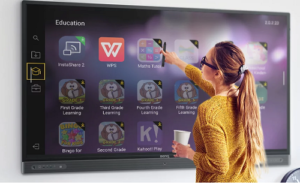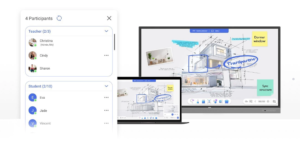There is a lot of research on the impact of audio visual technology on academic achievement and surprisingly, the results are not as clearcut as you might expect. Studies suggest that using audio visual technology such as interactive screens and projectors in the classroom can improve academic performance, while others show no significant difference.
We know first-hand how much audio visual technology has transformed the schools we have worked in. It has evolved significantly since we started out in business in 2008 and has revolutionized the way students learn and teachers teach in recent years. The incorporation of audio visual tools such as videos, images, and interactive software has opened up new avenues for learning and boosted student engagement. Here are some of the ways audio visual technology has had a positive impact on education:
Increased student engagement
When I remember back to my time at school, the main source of engagement came from the teacher and the notes she put on the chalk board (I’m showing my age now!). That was back in the 1980s. Teaching tools pretty much remained the same throughout the ‘90s and early 2000s except for chalk boards being replaced by whiteboards and overhead projectors. Then very quickly, audio visual technology took off and suddenly, many classrooms were sporting projectors and interactive whiteboards, arguably making the children’s learning experience far more interesting.
Now projectors and boards have been replaced by standalone interactive screens with built-in PCs, offering multi-point touch. Students can actively participate digitally with the lesson. This could be via a chrome book or an iPad. The options are endless.
Audio visual technology has the power to grab students’ attention and make learning more fun. Students can learn complex concepts through visually engaging videos and animations, which make the subject matter more understandable and enjoyable. That said, audio visual technology complements and aids teachers and in no means is meant to replace the ability of a good teacher to provide engaging material and deliver interesting lessons.
Enhanced learning experiences
Audio visual technology allows teachers to create custom learning experiences that cater to the needs of each student. With interactive software, teachers can adjust the pace and difficulty of lessons to ensure that students remain engaged and challenged.
For example, BenQ, one of our most popular touchscreen providers, offers EZWrite, the board’s built-in whiteboarding app. This app has become a very useful collaborative learning tool. Teachers can activate its cloud whiteboarding feature, which allows their students to participate from anywhere in real time, which is ideal for absent students. This reduces the need to catch up due to unavoidable absence.
Teachers are now also able to access their Google Classroom files directly from the BenQ Board. Regardless of which building they’re in or what classroom they’re using, as long as there is a BenQ Board in the room, they can easily log in by scanning a QR code and access their lesson materials in their cloud folders.
BenQ’s ‘InstaShare’ wireless screen sharing solution not only allows teachers to cast their laptop screens onto the display, it also gives them the ability to share the live camera feed from their phones. This is particularly useful when performing experiments during their science and engineering classes, as teachers can use their mobile phone camera to give their students a closer look when demonstrating step-by-step procedures. Students no longer need to crowd around their teacher’s desk since everything is already clearly displayed on the board*1 .
Improved retention
We all learn differently, for example some of us are visual or audible learners while others are kinaesthetic or olfactory (taste and smell) learners. This is supported by studies which have shown that students retain more information when presented with visual aids that help them understand concepts and ideas better and helps them to remember the information for longer.
This is the beauty of interactive audio visual technology. The teacher has greater access to unlimited videos, images and other resources available, therefore appealing to the large range of learner types in their classroom. That said, the capabilities of an interactive screen are not quite as advanced as to provide resources that provide a full sensory experience utilising smell, touch or taste although I’m sure it will only be a matter of time!
Another benefit is that it enables students to learn at their own pace and review material as many times as they need to, which is integral to firmly cementing the lesson content in the student’s memory.
Accessibility
Audio visual tools are especially useful for students with disabilities, such as those who are hard of hearing or visually impaired. Captions and subtitles on videos can make content more accessible.
BenQ’s ‘InstaShare’ wireless screen sharing solution not only allows teachers to cast their laptop screens onto the display, it also gives them the ability to share the live camera feed from their phones. This is particularly useful when performing experiments during their science and engineering classes, as teachers can use their mobile phone camera to give their students a closer look when demonstrating step-by-step procedures. Students no longer need to crowd around their teacher’s desk since everything is already clearly displayed on the board.
In summary
As aforementioned, the effectiveness of audio visual technology depends on how it is used. Simply showing a video or PowerPoint presentation is not enough to improve academic achievement. Teachers must also use effective teaching strategies to help students understand the material and apply it to real-world situations.
Overall, while audio visual technology can be a useful tool for enhancing learning, it is not solely responsible for improving academic achievement. It is right to suggest that it increases the chances of engaging more learners, but it is important for teachers to use audio visual technology in conjunction with effective teaching strategies and something which technology can’t deliver – personality!
The potential for increased academic performance is certainly there with the the introduction of audio visual technology in collaboration with effective teaching to ensure that students are engaged and learning effectively.
REFERENCES
*1 www.benq.com


